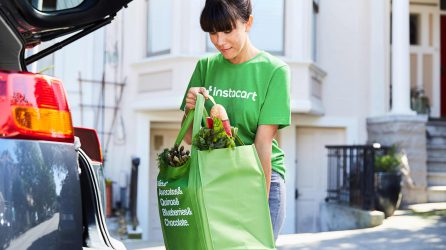How to build a data-driven CPG organization, in 5 steps

Presented by:
Stephanie Rubin — 2021
At a time when more buying is shifting to online and shopper habits continue to change rapidly, data strategy is rising up the agenda for many CPG organizations.
In a recent report, McKinsey highlighted a ‘reset of data-driven marketing’ as one of the key behaviors forward-looking CPGs needed to adopt to succeed post-pandemic. “Leading CPG companies will lean into rapid but thoughtful redeployment of marketing resources after navigating major shifts during the crisis and current waves of change, including the end of the cookie era and the growth of retailer media networks,” McKinsey said in the report.
“They will proactively reset their data strategies – considering the role of D2C and first-party data access, supported by a marketing technology partnership network – to build deeper consumer relationships and deliver the right message, through the right channel, at the right time.”
Data strategy is rising up the CPG agenda for other reasons, too. The simple fact that there’s so much more data available and a growing number of trends and marketplaces to track means that ‘following your gut’ just isn’t a viable approach to decision-making anymore.
To make decisions with confidence and at pace, CPGs need a systematic approach to data which not only removes the guesswork but embeds data-led thinking right across the organization.
Here are five steps and principles that can help.
Step 1: Set clear business objectives
When you’re looking to embed more data into your decision-making process, it’s easy to get trigger-happy and amass piles of data just for the sake of it. After all, you might as well collect what you can and then figure out what to do with it later, right?
But this is counterproductive.
Data is a tool to help drive better business outcomes. Capturing, collating, and analyzing data isn’t useful in and of itself. The business results are what matters. In fact, when it’s not tied to clear business goals, data can quickly overwhelm CPG teams and become a distraction.
So, always start with the fundamentals:
- What’s the end goal here?
- Why do you want to collect this specific bit of data?
- What business questions are you hoping to answer with it?
- How will you use these answers to drive meaningful change and outcomes for your organization?
Make sure you then communicate the end goal across your business, so you can rally everyone behind the same objectives, measures, and outcomes. And think quality over quantity. Becoming more data-driven isn’t necessarily about having more data; it’s about having better data, and making smarter decisions based on that data.
Step 2: Spend as much time on the ‘why’ as on the ‘what’
Tunnel vision is a real risk as organizations try to become more data driven. I see a lot of CPGs get so stuck in the numbers – agonizing over every tenth of a percentage point change in their scorecard – that they miss the bigger picture.
Quantitative data is useful, but it only ever gives you part of the story. It tells you what is happening, not why. If you make decisions based solely on what your data scientists see in the cold, hard numbers, you won’t necessarily make the right decisions.
To drive the right outcomes, always consider the qualitative side of the data and make sure you understand the business context. Talk to consumers, talk to your customers, and find out why they do what they do. Visit retailer websites and walk through grocery stores so you can see for yourself how your products and promotions are displayed. There are things that numbers on a piece of paper can’t tell you.
Step 3: Integrate your data scientists into the wider organization
Few things will derail your ambitions for building a data-driven CPG organization faster than data scientists working in silos.
Having dedicated data and analytics experts is great, but be wary of teams that act like islands unto themselves.
You need your data scientists to understand the wider business context so they can interpret the data correctly. Otherwise, you’ll quickly find that you can’t get a solid read on the ‘why’ and will struggle to connect your data to your business objectives.
Step 4: Connect the dots between different data sources
I’ll be the first to admit this is a tall order, but I believe it’s a reality CPGs need to grasp if they want to thrive in the eGrocery era.
If you’re serious about understanding the ‘why’ behind your data, you can’t just look at individual sources of data in isolation. Increasingly, you must be able to integrate multiple sources to build up a more comprehensive picture.
This could take the form of tying in-store and online measures together, for example. Or combining transactional data (where it is available; Kroger’s recent move in this area was welcome news) with your digital shelf analytics and your marketing spend or rate cards to calculate a more accurate ROI on media spend.
Wherever you can, don’t let your data linger in separate buckets or lakes. Find ways to connect the dots. It’s how you’ll unlock some of the most valuable insights.
Step 5: Invest in ‘just in time’ data training
In a Harvard Business Review article on creating a data-driven culture, David Waller writes that many organizations still rely too much on ‘big bang’ training efforts to upskill staff. But if employees aren’t given an opportunity to apply new skills straight away, Waller points out, such skills are quickly forgotten.
This is certainly something I see within CPG – both around data and eCommerce training more generally. It’s all too easy to overwhelm staff with information that has nothing to do with their day-to-day, or to expect them to be experts after a single day of training.
Instead of the traditional ‘one and done’ approach, consider offering training in smaller, bite-size instalments that relate directly to projects your employees will be working on in the next week or month. Allow them to try out their new data skills, provide feedback, and then offer refresher sessions or additional training as and when required.
You have to have data-led thinking built into your organizational culture for it to really catch on. It’s not a one-time event.
All the digital Shelf Analytics You Need to Succeed at Speed & Scale
See why world leading brands choose e.fundamentals for actionable digital shelf insights
Request A demoLatest Resources

CommerceIQ Launches Global Retail Ecommerce Management Platform Combining Sales, Supply Chain, Retail Media, and Digital Shelf with e.fundamentals Acquisition
Ecommerce platform enables consumer brands to grow market share profitably in today’s inflationary and supply-constrained environment through intelligent automation, supporting over 450 omnichannel retailers in 41 countries.

e.fundamentals becomes a CommerceIQ company
e.fundamentals has been acquired by CommerceIQ, the leading Retail Ecommerce Management Platform, headquartered in Palo Alto, California. Consumer brands can now harness one global software platform to power profitable market share growth across all major retailers.

5 strategic pricing opportunities CPGs should focus on now
As tensions run high between retailers and suppliers, CPGs need to be smarter than ever about strategic pricing. Here’s how to use digital shelf analytics to hold your own in tough negotiations.

What the smartest CPGs get right about selling on Instacart
This post has been updated and was originally published March 30, 2021. It's time CPGs get ready to win on Instacart. So read and learn: What's all the hype around…

5 optimization tactics to grow digital shelf sales
This post has been updated and was originally published May 14, 2020. Consumer goods companies (CPG) continue to grapple with enormous shifts to the industry as the eCommerce boom continues…

5 tactics to grow online sales for category managers
Category management has changed. We've highlighted the 5 tactics to help you scale your growth on the digital shelf at speed.
View Our Most Popular resources to help you learn and win on the digital shelf.

The Ultimate Guide to Content Management on the Digital Shelf

The Digital Shelf Cast - Listen to our latest episode





